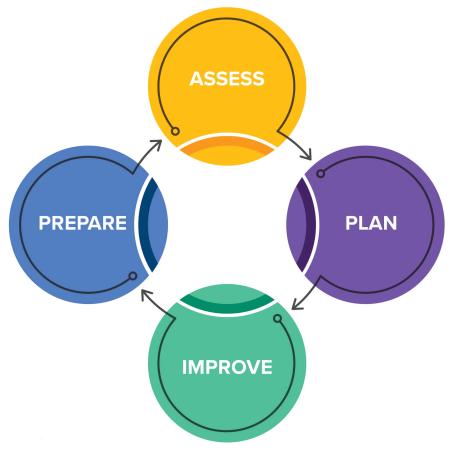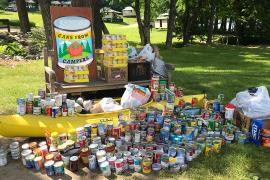As established in the first “Lessons Learned” article (in Camping Magazine, September/October 2023), program quality (PQ) is essential to youth programs, and research shows that high-quality programs are directly linked to more positive outcomes for young people.
The previous text covered the basics of what PQ is, who Tims Camps is, the continuous improvement cycle, and tips and tricks for the first two phases of the cycle (Prepare and Assess). This installment of the series focuses on the final two phases of continuous improvement (Plan and Improve).
Review from Part One
What is PQ?
- The environment created at camp through staff practices. When the camp environment is safe, supportive, interactive, and engaging, participants experience greater PQ.
- Conducting PQ assessments can provide invaluable data to strengthen programs and help more youth benefit from positive outcomes camp programs are designed to foster.
Who is Tims Camps?
- Tims Camps’s mission is to help youth from underserved communities achieve their full potential.
- We operate seven camp locations across the United States and Canada and serve youth through three different program models: summer, school, and partnerships.
- Research and measurement are highly valued at Tims Camps. We approach measurement holistically, measuring not only the outcomes and impact of our programs, but also how we deliver programs using a PQ lens. We began structured PQ assessments during summer 2021.

Continuous Improvement Cycle Phases
The following four phases make up the continuous improvement cycle that is used in reference to PQ work:
- Prepare — set your team up for success with PQ assessments through education, training, and planning.
- Assess — measure PQ through observations and scoring.
- Plan — use assessment data to plan for future program improvements.
- Improve — implement action plans to directly and positively impact program quality.
Prepare and Assess Tips and Tricks
- Prepare:
- Assemble an assessment team.
- Decide on which PQ tools to use and how much data to collect.
- Train the team.
- Assess:
- Create an assessment plan.
- Create a contingency plan.
- Determine how scores will be collected.
- Consider how to implement learnings from assessments.
Plan
At Tims Camps, PQ data is used to develop improvement plans both immediately after assessments and holistically after each operating season. Supporting individual camp locations in short-term goal setting and planning using data in real time helps us to improve PQ during peak operations. Coming together annually as an organization to review collective data guides our improvement efforts more broadly in the year to come.
We measure PQ multiple times per season at each camp location through camp team self-assessments and visitor assessments conducted by our centralized support team. A reflection and discussion meeting occurs after any assessment during which the observation notes and assessment are reviewed, and the team identifies areas of strength, improvement, and at least three action steps for prompt implementation to address the areas identified. This immediate review process is critical to ensuring ongoing improvements to PQ. The discussion during this time is essential to pause and consider what is or is not happening at camp and why. Reflecting on the findings and making sense of them is the first step toward improvements.
At our annual “Planning with Data” workshop, we bring together leadership teams from each camp location to discuss the assessments, data, and learnings from the whole year. Each team reviews data from their own location and organization-wide information. It’s valuable for everyone to see their own and other locations’ data to strategize holistically and to share best practices from one location to another. The discussion and goal setting that takes place during this meeting informs the organizational actions that occur during the Improve phase. We spend time making meaning of the data we have collected through examining what some of the root causes may be for identifying specific areas for growth and strength. We then set goals and make plans to address some of the root causes so we can improve in the future. At Tims Camps, we identify one organization-wide goal that everyone is accountable for, and each camp location sets a goal of their own based on individual improvement areas. Finally, the PQ assessments and improvement process is reviewed, and modifications are discussed.
Plan: Tips and Tricks
Create a process for incoming PQ assessments that outlines:
- How assessments will be reviewed as they are collected and by whom.
- How data should be used to inform immediate improvement actions.
Outline an annual process for reviewing data and setting goals. Whether you host one camp or oversee a network of camps, you should develop a process that details:
- Who is responsible for preparing all material required for data review and leading the review process and what it looks like.
- A system for calculating an average grade that makes sense for you. This should remain consistent and give you a way to measure progress over time. Who is responsible for calculating the score?
- Who should be involved in the process of reviewing data and setting goals based on what you learned. (Keep in mind, having different people with different perspectives at the table can be helpful. For example, a camp director may create an action step that a counselor doesn’t feel is feasible given daily camper schedules.)
Improve
Once you have conducted assessments and reviewed your data, it is time to use that learning to improve.
Immediate Improvement Actions
Although it may yield great change, the most challenging time to implement improvement efforts is during peak operations. Camp becomes a busy place with competing priorities when staff and youth are on site. Plus, with the high turnover and seasonal nature of many camp positions, it can be hard to find staff with a deep enough understating of PQ-related principles to support improvement efforts.
Despite challenges, using learnings in the moment can be beneficial to improving PQ quickly. We’ve found that a focus on immediate data-based action plans has been successful. Some examples that have worked well for us include:
- Staff in-service or training sessions based on areas identified for improvement (e.g., another training on facilitation skills to support “scaffolding learning”)
- Incentives to encourage positive staff behaviors (e.g., a reward for “staff of the session” for modeling certain behaviors based on PQ components, such as always following the same rules as the campers)
- Quick changes to lesson and program plans to include missing components (e.g., during climbing, make sure to include a portion of time at the beginning where campers are encouraged to set personal goals)
Long-Term Improvement Actions
Overall, while we’ve actioned immediate learnings during the peak summer season, we have had greater success adhering to an annual cycle of continuous improvement by creating and working toward goals outside of the summer months. These goals are more formal, assigned to full-time, year-round staff members, and offer greater opportunity to execute improvement plans associated with them. These goals are measured for completion after one full year of improvement efforts.
Some examples of action steps related to annual improvement goals include:
- Implementation of new programs to address gaps in core PQ elements (e.g., activities designed to cultivate empathy or provide campers with leadership opportunities)
- New approaches to staff training to improve staff competency in certain PQ areas (e.g., more targeted training on supporting campers with managing emotions, debriefing, and facilitating activities)
Improve: Tips and Tricks
- Make realistic action plans that take into account capacity and resources, especially related to immediate improvement plans.
- Determine how many goals for improvement make sense and how to ensure accountability when measuring and celebrating successes.
- Work directly with staff to deliver improvement plans and repeatedly reference how plans connect to quality practices.
Although there are challenges and barriers to prioritizing and implementing PQ at camp, the impact it has on the staff and camper experience makes it worthwhile. Investing in quality pays dividends. It’s a proactive approach to creating positive experiences and preventing behavior issues, supporting mental health and well-being, and keeping campers engaged. By showcasing a commitment to quality, staff understand you care about supporting their job performance and skill development. Campers may not realize it, but when there’s a focus on delivering high-quality programs, they are more likely to be immersed in all that camp has to offer — fun, learning, friendships, and more.
Lacey Maglinger is the senior manager, program quality and development at Tim Hortons Foundation Camps. She has worked with the organization since 2012 in various roles. Currently, her work includes conducting PQ assessments, supporting camp teams in collecting PQ data through assessments, and using PQ data to improve programming and create resources for camp teams.
Victoria Povilaitis, PhD, is the director of program innovation at Tim Hortons Foundation Camps. In this role she guides program quality, outcome, and impact measurement and uses these data to inform program development and facilitation.


